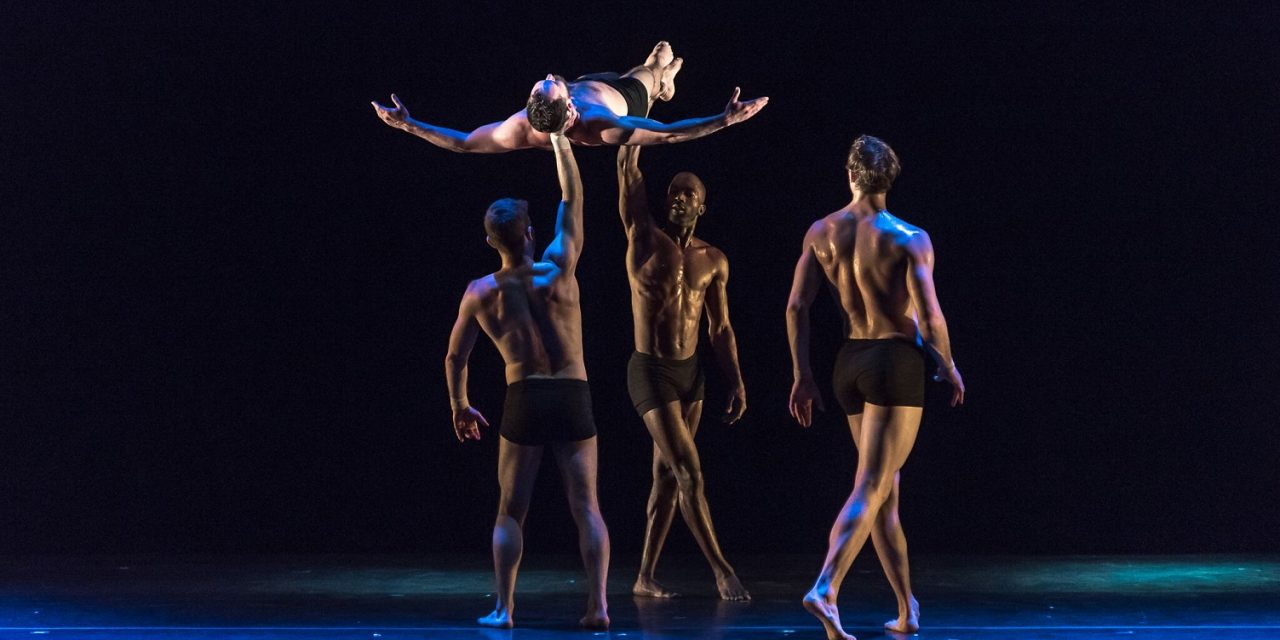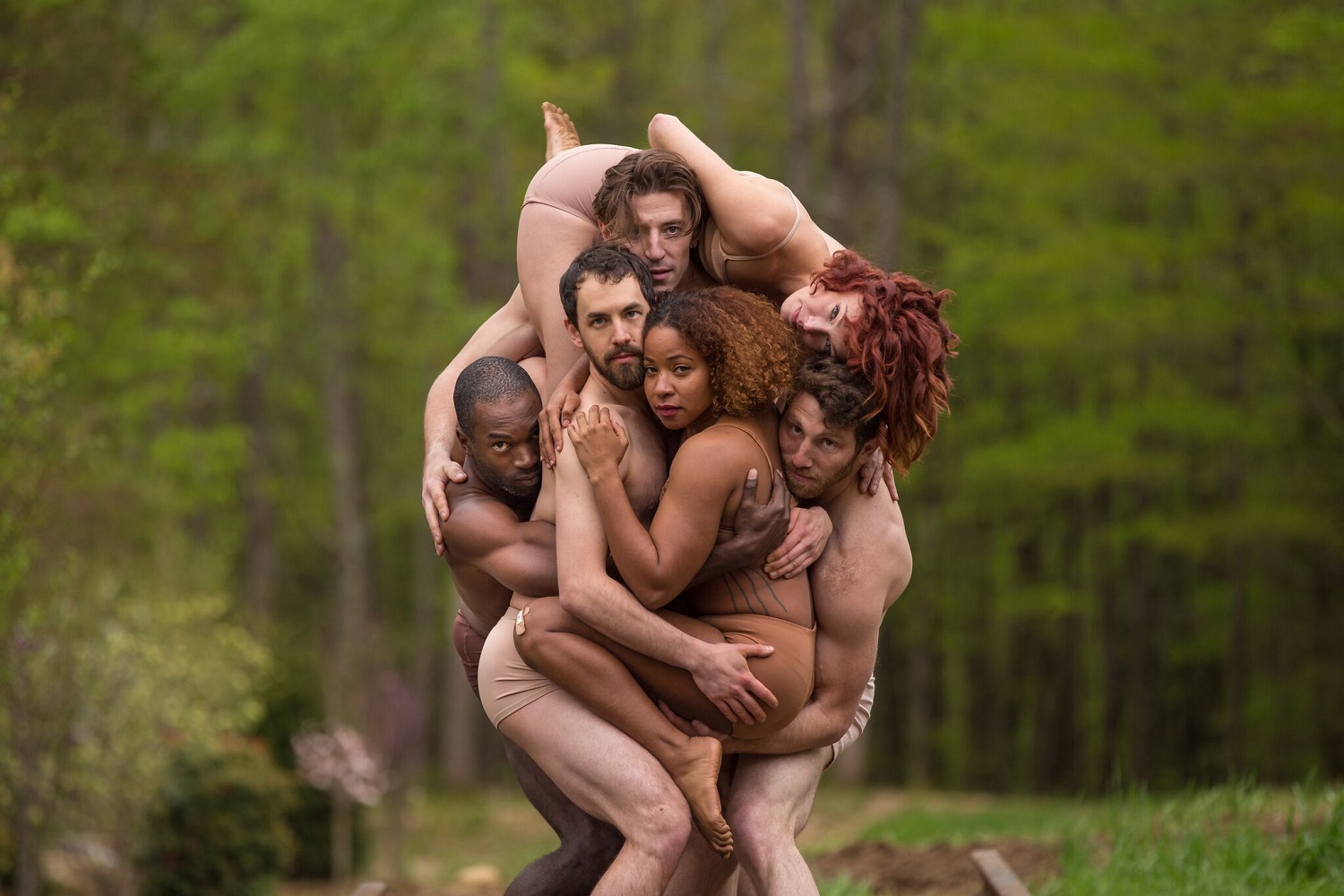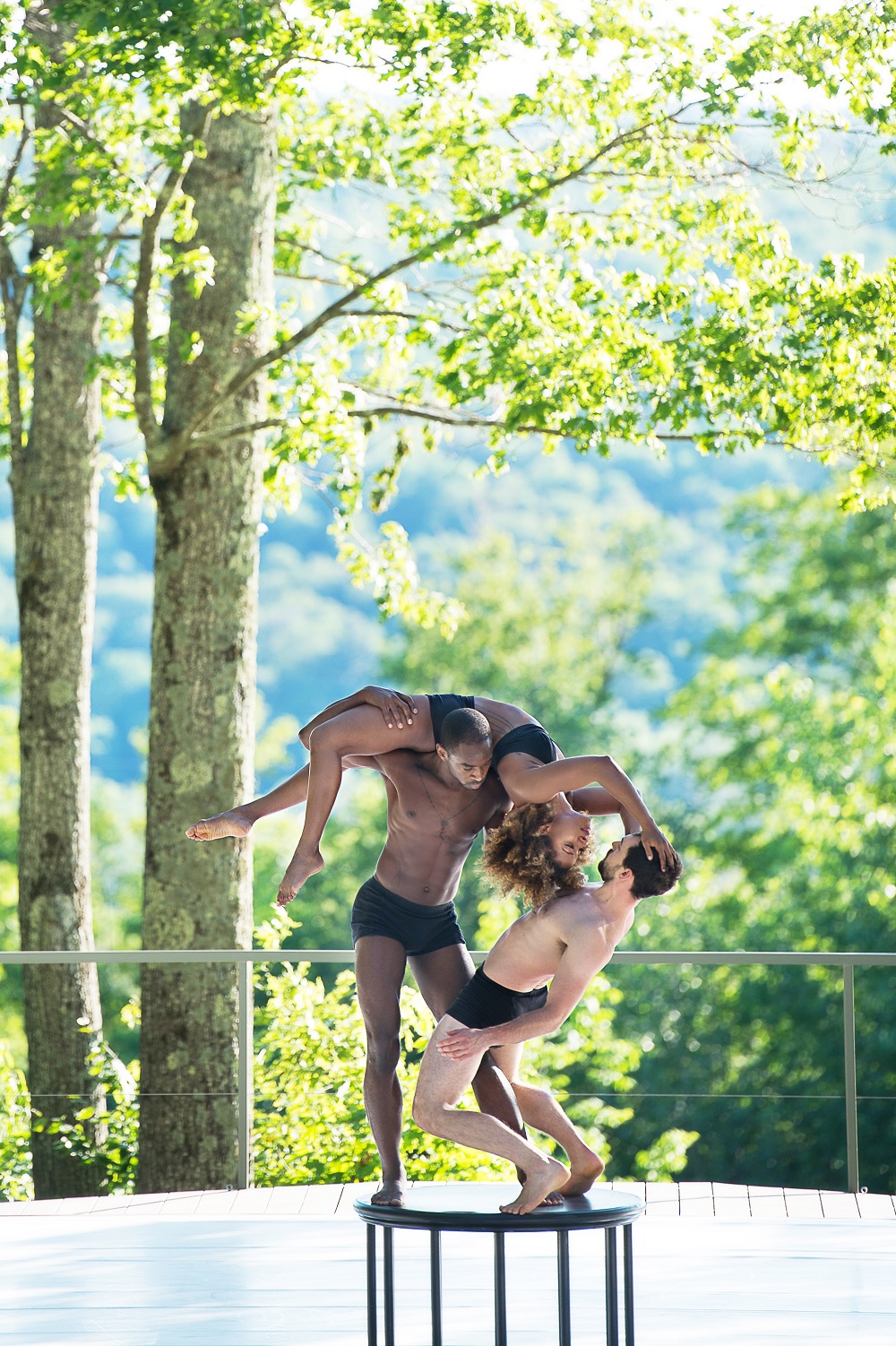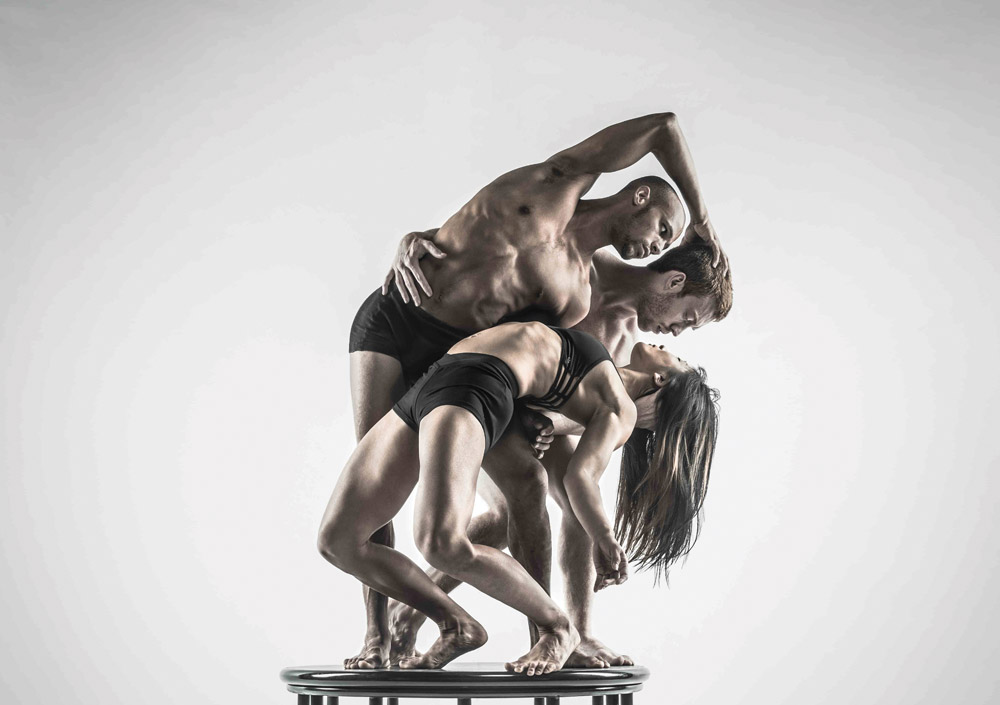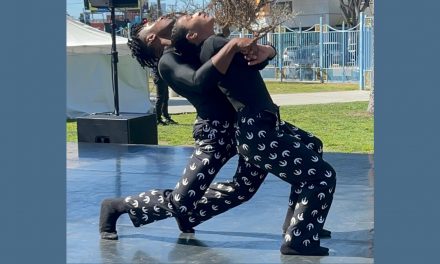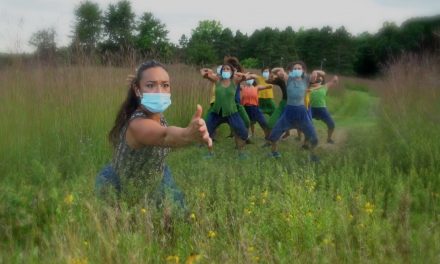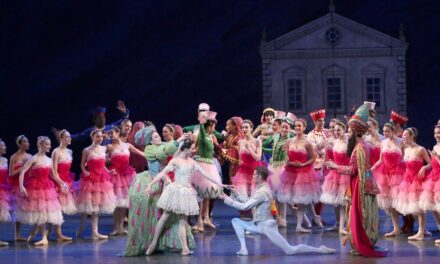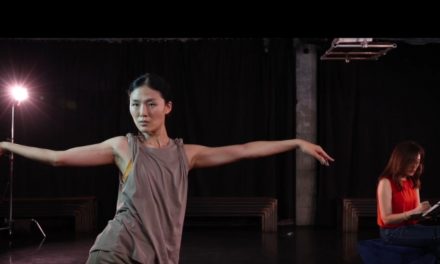As part of its residency at the Chapman University Department of Dance, Pilobolus presented Come To Your Senses at the beautiful Musco Center for the Arts and for a mid-week performance, the large turnout spoke to the company’s excellent reputation.
Pilobolus got its start at New Hampshire’s Dartmouth College in 1971 when Moses Pendleton, an English literature major and cross-country skier; Jonathan Wolken, a philosophy science major and fencer; Steve Johnson, a pre-med student and pole vaulter met in a dance composition class taught by Alison Becker Chase. The first dance that they made together was titled Pilobolus by Wolken who had learned about the genus of fungi that grows on herbivore dung in class. The men decided to continue working together and the now world-famous company included founding members Robby Barnett, Alison Chase, Martha Clarke, Lee Harris, Moses Pendleton, Michael Tracy, and Jonathan Wolken.
Since leaving Pilobolus, Martha Clarke has become a renown choreographer, dance and theater director. Moses Pendleton went on to form MOMIX, and Alison Chase founded Apogee Arts with a touring program called Alison Chase/Performance. Michael Tracy is currently on Pilobolus’ Board of Directors, and Barnett is on the Advisory Committee of American Dance Festival. Sadly, Jonathan Wolken died in 2010 at the age 60.
The current Artistic Directors of Pilobolus are choreographers Renée Jaworski and Matt Kent, and the exceptionally talented, highly trained and expertly rehearsed dancers included Nathaniel Buchsbaum, Krystal Butler, Isabella Diaz, Zachary Eisenstat, Quincy Ellis, Heather Favretto, and Jacob Michael Warren.
As we entered the theater, company members were warming up on stage, speaking to audience members and posing for photographs. It was a somewhat staged relaxed atmosphere designed to draw the audience into their world. The process worked and by the time the performance began the audience’s attention was completely focused toward the stage.
The program included five works, each separated by videos described as “transmedia digital creations”. Eye Opening, created by Renée Jaworski and Matt Kent in collaboration with several dancers, began with an audience member, Amanda, being brought up onstage and instructed on her role in the piece. Amanda acted as a silent narrator and teacher, holding up information cards that described what was happening, and informing us about the evolution of the eye. The text was visible to the audience via a handheld camera onstage that projected onto a large screen. As Amanda began her class, dancers appeared wearing large cartoon-like eyes on their heads, moved props around and mugged into the camera as the scientific information was explained and demonstrated. Although Eye Opening was mildly amusing and informative, it appeared more suited to a much younger audience.
The cast include all seven company members. The Lighting Designer was Trevor Burk with Art Direction by Greg Laffey and Sound Design by David Van Tieghem.
Gnomen was choreographed in 1997 by Robby Barnett and Jonathan Wolken in collaboration with Matt Kent, Gaspard Louis, Trebien Pollard, and Mark Santillano performed flawlessly by Buchsbaum, Eisenstat, Ellis and Warren who entered the stage as a rolling, human wheel. The work featured each man being manipulated, lifted, carried and supported in a numerous of inventive configurations, beginning with the tallest member of Pilobolus, Jacob Michael Warren. Warren appeared as a giant in relation to the other men, but they easily carried him around in a lyrical and bordering on religious manner until the sound of a gong brought the section to its conclusion and the men ceremoniously noded their heads in response.
The following sections involved one low crouching man being guided around the space like an obedient pet dog. Another was carried about the space leading into the fourth section that took on a more sculptural look with the featured dancer lifted off the ground by the other men’s feet. Each section, and the end of the dance, concluded with the four men slowly bowing their heads as if a required ritual had been completed.
There are a several definitions of the noun gnomen. One is an object that by the position or length of its shadow serves as an indicator of the hour of the day: such as the pin of a sundial or a column or shaft erected perpendicular to the horizon. The second is the remainder of a parallelogram after the removal of a similar parallelogram containing one of its corners. Yet another dictionary states that gnomen is the plural of gnom, a man seen as despicable. It was not clear which definition Gnomen was inspired by.
The music for Gnomen was by Paul Sullivan; Throat Singing by Matt Kent; Costume Design & Construction by Eileen Thomas; and the beautiful, soft Lighting Design was by David M. Chapman.
Choreographed by Michael Tracy in collaboration with Otis Cook and Renée Jaworski, Symbiosis is a very sensual duet performed here by Isabella Diaz and Jacob Michael Warren. As the lights came up on the stage, we saw Warren seated next to a reclining Diaz. He reached across and seemingly absorbed her into his being. It was an intriguing image; one body disappearing into another like a human cell sucked in by another. Warren then slowly carried, lifted and deployed Diaz throughout the space. His strength and size even more apparent with Diaz attached to his chest, lying parallel to the floor on top of Warren’s head, or being physically tumbled over and around his person.
Both in flesh tones, Warren was dressed in a loin cloth and Diaz in halter and briefs. The work was erotic but not quite romantic, and it was a feat of strength for both performers. It spoke to a dependency, symbiotic relationship and when Diaz briefly attempted to detach herself from Warren, we saw how her existence depended on his. The exit for Symbiosis was unexpected and wonderful, and foresaw their future as their tumbled offstage firmly and forever connected.
The primitive evoking costumes were by Designer Angelina Avallone and the atmospheric lighting by Designer Steven Strawbridge.
Warp & Weft was a fluff piece and reminiscent of Alwin Nikolais, MOMIX and other groups that incorporate large props into the movement. Choreographed by Renée Jaworski and Matt Kent in collaboration with other dancers, the works opened with what resembled a giant whirling red propeller blade with the sound score a reflection of that image. The shiny red material became a vehicle for several oversized creatures including a singer with large, mobile breasts and elongated arms. Dancers bobbled beneath the material to cartoon-like sounds and used it to form a very tall woman. Although highly entertaining for the audience, the shapes created by the three wonderful performers Krystal Butler, Isabella Diaz, and Heather Favretto were totally predictable as they have been seen throughout the history of dance and theater.
Music for Warp & Weft was by Thao Nguyen; Costumes by Márion Talán; Lighting by Diane Ferry Williams; and Sound Design by David Van Tieghem.
The best was saved for last with the thoughtful and creative work choreographed by Jaworski and Kent in collaboration with the dancers. Branches depicted the migration of a flock of birds. We saw them soar in, wade and wash in a pond, mate and then continue on their seasonal journey. Costumed in minimal clothing of flesh tones, Branches is a very intelligent work which used bird-like movements, but that did not explicitly mimic the creatures. The only time the choreography faltered was during the section where the creators introduced inane humor to express the male birds strutting and vying for the females’ sexual attention. It caused their sought after laughter, but weaken the piece.
There was, however, a gorgeous and romantic duet between two females, as well as a male/female couple performing while two other duets performed in unison behind them. The movement was very different for Branches than in the other works presented on the program and there was a clear thread that ran throughout. In Branches, the choreographers mostly separated themselves from entertainment to create a work of art. Presenting it at the end of the program was wise.
Pilobolus has always appealed to a wide array of audiences, wonderfully bridging concert dance with entertainment. All the works were beautifully rehearsed and featured amazingly talented, agile and strong performers. All the production elements of Pilobolus were excellent save one, the music. The selections as heard on this night were not the best and the editing was embarrassingly poor for a company with this standing and funding.
For more information on Pilobolus, click here.
For more information on the Musco Center for the Arts, click here.
Featured image: Pilobolus in Gnomen – Photo courtesy of the company.

